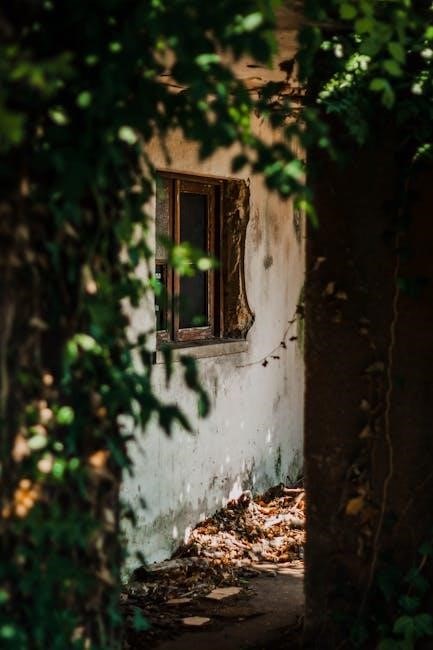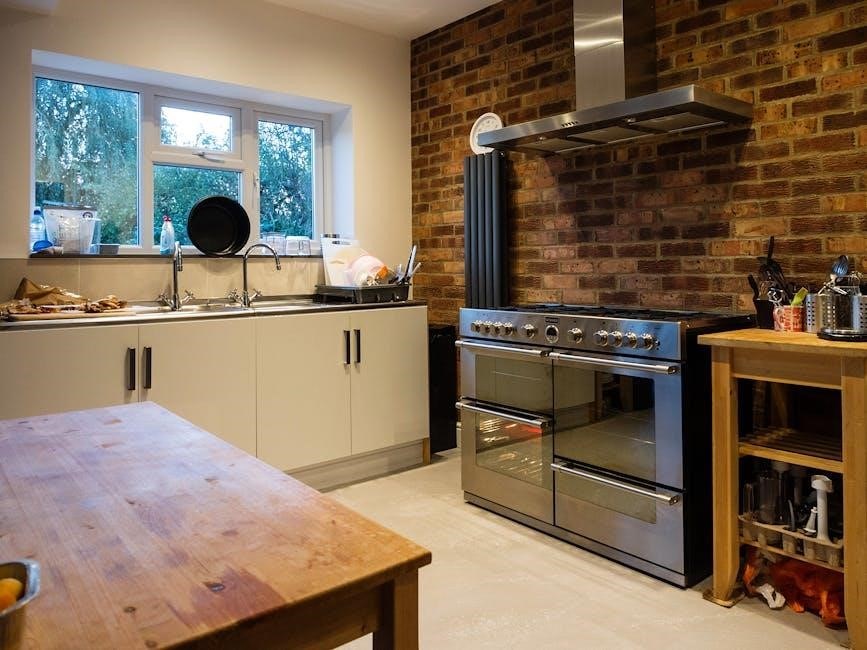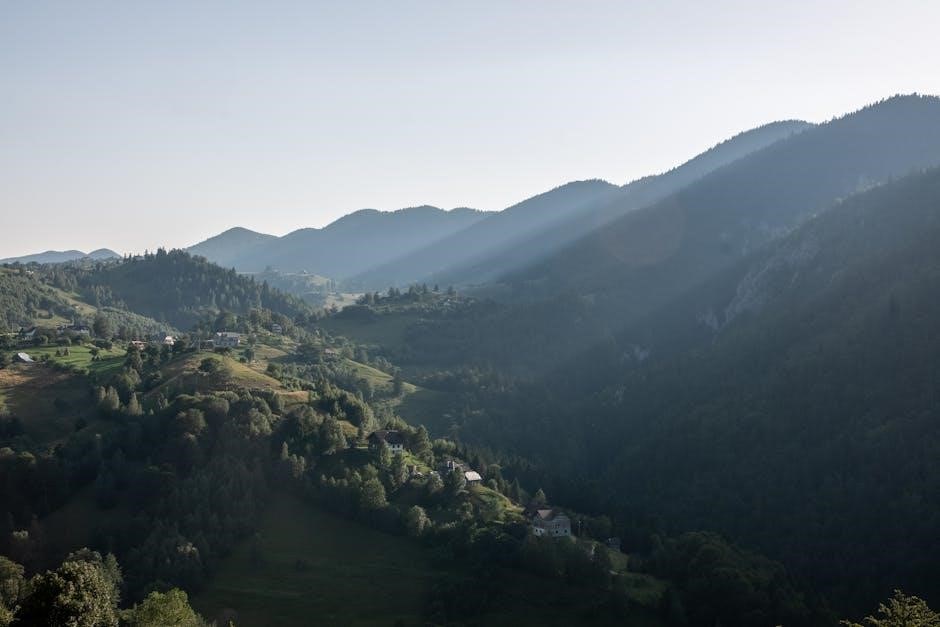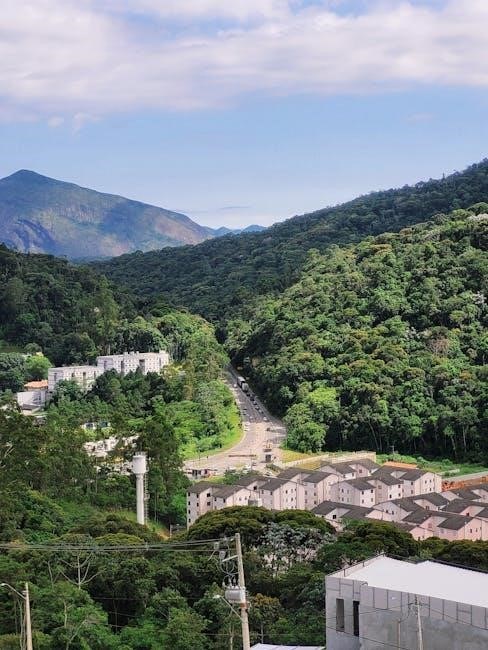Discover the art of crafting hidden villages in Minecraft, blending creativity with functionality. Learn to design secluded settlements, incorporating natural elements and clever structures for a unique experience.
Understanding the Basics of Minecraft Villages
A Minecraft village is defined by the presence of at least one house and one villager. A house is typically marked by a bed, which serves as the core for villager spawning and breeding. Villagers require specific structures, like beds and workstations, to function and reproduce. The game’s AI dictates their behavior, with villagers following routines based on time and resource availability. Villages can exist in various biomes, each offering unique challenges and opportunities. Proper lighting and visibility are crucial to prevent mob spawns and ensure villager safety. Understanding these fundamentals is essential for building a thriving and functional village, whether it’s hidden or open. Start by mastering the basics to create a solid foundation for your secret village design.
Why Build a Secret Village?
Building a secret village in Minecraft offers a unique way to protect your creations from mobs and other players while adding an extra layer of creativity to your gameplay. Hidden villages provide a sense of exclusivity and security, allowing you to focus on designing a thriving community without external threats. It also challenges your building skills, pushing you to think strategically about placement and design. A secret village can be a standout feature in your world, showcasing your ability to blend structures seamlessly into the environment. Whether for survival purposes or aesthetic appeal, a hidden village adds depth and intrigue to your Minecraft experience, making it a rewarding project for any builder.
Overview of the Secret Builder’s Guide
This comprehensive guide is designed to help Minecraft players master the art of building secret villages. It covers everything from planning and design to advanced techniques and final touches. The guide begins with the basics, such as understanding village mechanics and choosing the perfect biome. It then dives into detailed steps for constructing essential structures, including houses, community buildings, and defensive walls. Advanced topics like hidden passages, redstone mechanisms, and elevation design are also explored. Additionally, the guide emphasizes aesthetics, functionality, and optimization, ensuring your village is not only secret but also vibrant and efficient. By following this guide, you’ll learn how to create a unique, hidden world that feels lived-in and secure, enhancing your Minecraft experience with creativity and strategy.

Planning Your Secret Village
Start by selecting a secluded biome and sketching a layout that blends naturally with the environment, ensuring your village remains hidden and visually appealing.
Choosing the Right Biome for Your Village
Selecting the appropriate biome is crucial for a secret village. Forest biomes offer natural camouflage with dense trees, while mountain or cave biomes provide innate concealment. Desert biomes can blend seamlessly with sandy terrain, and swamp biomes hide structures among water and foliage. Consider the resources each biome offers—forests provide wood, deserts offer sandstone, and mountains supply stone. Ensure the biome aligns with your design aesthetic and functionality. A well-chosen biome enhances both the secrecy and sustainability of your village, making it harder to detect while providing essential materials for construction and survival.
Designing the Layout of Your Village
Plan your village layout meticulously to balance functionality and secrecy. Start with a central hub, such as a town square, and expand outward organically. Ensure houses and buildings are spaced naturally to avoid suspicion. Incorporate winding paths and irregular shapes to mimic organic growth. Use terrain features like hills or caves to hide structures from view. Position essential facilities like farms and animal pens near the edge for easy access without compromising concealment. Add small details like torches, fences, and decorative elements to create a lived-in atmosphere. Avoid symmetrical or overly uniform designs, as they can draw attention. Instead, aim for a layout that feels spontaneous and blends seamlessly with its surroundings, enhancing both the village’s functionality and its hidden nature.
Ensuring Proper Lighting and Visibility
Lighting and visibility are crucial for both functionality and aesthetics in your secret Minecraft village. Strategic placement of torches or glowstones ensures that key areas are well-lit, preventing mob spawns and creating a welcoming atmosphere. Use natural light during the day by incorporating open spaces or glass roofs. For visibility, ensure that pathways are clear and logical, guiding villagers and players through the village seamlessly. Avoid overly dark areas that could compromise the village’s usability. At the same time, balance lighting with secrecy by using subtle illumination sources like lanterns or hidden glowstone strips. Proper lighting enhances both the charm and functionality of your hidden village, making it easier to navigate while maintaining its concealed nature.

Building Essential Structures
Constructing essential structures like houses, community buildings, and defensive walls is vital for functionality and aesthetics. Use materials wisely to create efficient, visually appealing designs for your village.
Constructing Houses for Villagers
Building houses for villagers is essential for creating a thriving community. Each house must include a bed, which defines it as a valid dwelling. Start with a simple design, using natural materials like wood or stone to blend seamlessly with the environment. Consider the size and layout, ensuring enough space for villagers to move comfortably. Add details like windows, doors, and small gardens to make the houses feel lived-in. For a secret village, opt for underground or hidden structures to maintain stealth. Experiment with unique architectural styles while keeping functionality in mind. Properly constructed houses will attract and sustain more villagers, enhancing your village’s growth and activity. Pay attention to lighting and accessibility to ensure a welcoming and functional space for your villagers.
Creating Community Buildings and Facilities
Community buildings and facilities are vital for a functional and engaging secret village. These structures serve as gathering points for villagers and enhance the village’s atmosphere. Consider adding a town hall, marketplace, or community center where villagers can interact. For a secret village, integrate these buildings seamlessly into the environment, using natural materials and designs that camouflage them from view. Incorporate details like torches, signs, and decorative elements to create a lively feel. Facilities such as farms, wells, or animal pens support villager sustainability. Ensure these buildings are strategically placed to maintain the village’s hidden nature while fostering a sense of community and productivity among the inhabitants. Properly designed community spaces will make your secret village feel vibrant and alive.
Designing Defensive Structures and Walls

Defensive structures and walls are crucial for protecting your secret Minecraft village from threats. Use durable materials like cobblestone or obsidian to construct high, reinforced walls. Incorporate overhangs, battlements, or archer slots for added security. A gatehouse with a redstone-powered gate can control access, while traps like pitfalls or tripwires can deter invaders. Consider natural defenses, such as surrounding the village with water or lava moats. To maintain secrecy, blend walls with the environment by using dirt, grass, or leaves as camouflage. Ensure walls are at least four blocks high to prevent mob spawning. Add torches or glowstone for nighttime visibility without compromising the village’s hidden nature. These defensive elements will safeguard your secret village while keeping it concealed from unwanted visitors.

Advanced Building Techniques

Elevate your builds with hidden passages, redstone mechanisms, and clever elevation designs. These techniques enhance functionality while maintaining secrecy, blending seamlessly into the environment for optimal concealment.
Adding Hidden Passages and Secret Rooms
Hidden passages and secret rooms are essential for creating a mysterious and secure village. Start by digging a 5×5 area and lining it with wood or stone to create a concealed pathway. Use pillar jumps or hidden doors to access these areas seamlessly. For added secrecy, blend entrances with the surroundings, such as hiding them behind waterfalls or foliage. Redstone mechanisms can automate door openings, enhancing functionality. Incorporate natural elements like vines or moss to make passages appear abandoned. For secret rooms, design cozy spaces with functional items like chests or crafting tables. Add decorative details like furniture or lighting to create a lived-in atmosphere. Consider building underground bunkers or elevated hideouts for extra security. These features not only enhance gameplay but also make your village uniquely intriguing and functional while maintaining its hidden charm.
Incorporating Redstone Mechanisms
Redstone mechanisms add functionality and interactivity to your secret village. Start with automated doors using pressure plates and hidden switches. This enhances security and convenience, allowing villagers or players to access areas seamlessly. Use Redstone lamps to create dynamic lighting systems, making your village feel alive. For defense, design traps or alarm systems to deter intruders. Incorporate hidden pistons to reveal secret passages or rooms. Redstone can also power water or minecart systems for transportation. To blend with aesthetics, hide Redstone components behind walls or under flooring. Experiment with creative mechanisms like automatic farms or sorting systems. These additions enhance both functionality and immersion, making your secret village a marvel of ingenuity and design.
- Automated doors and lighting
- Hidden switches and traps
- Transportation and utility systems
Using Elevation to Enhance Village Design
Elevation is a powerful tool for creating visually stunning and functional secret villages. By building on different levels, you can utilize natural terrain to hide structures from view. Start with multi-level homes, where upper floors offer breathtaking views while lower levels provide storage or secret rooms. Elevated walkways and bridges connect buildings, adding a sense of depth and complexity. Use staircases or ladders to navigate between levels seamlessly. Incorporate elevators powered by Redstone for easier access. Elevation also enhances defense by creating strategic vantage points. To maintain secrecy, blend elevated structures with the surrounding landscape, ensuring they remain hidden from distant views. Experiment with varying heights to create a dynamic and immersive village design that feels both functional and breathtaking.
- Multi-level structures for functionality
- Elevated walkways and bridges
- Redstone-powered elevators

Enhancing Village Aesthetics
Elevate your village’s visual appeal by adding decorative elements like glowing plants, water features, and intricate details. Use natural materials to blend seamlessly with the environment, creating a harmonious and inviting atmosphere that feels lived-in and unique.
Incorporating Natural Elements into the Village
Integrating natural elements enhances your village’s seamless blend with its surroundings. Use water features like rivers or ponds, and incorporate trees, flowers, and grass to create a lush environment. Adding natural materials such as wood, stone, and earth tones ensures the village feels organic. Consider building structures around existing terrain features like caves or cliffs to optimize space and aesthetics. Small details like animals grazing or flowing water add life and authenticity. These elements not only make the village visually appealing but also provide functionality, such as fishing spots or natural defenses, making it a thriving and hidden community.
Adding Decorative Details and Accessories
Add character to your secret village with decorative elements that bring life to its streets and buildings. Use torches, lanterns, and glowstones to create warm lighting effects, while flowers, vines, and hanging plants add color and texture. Place decorative items like barrels, crates, and market stalls to suggest daily villager activities. Small details such as bridges, benches, and signs can enhance the village’s charm. Incorporate unique features like wind chimes, banners, or even a village clock to make it feel lived-in. These accessories not only beautify the space but also create a sense of history and community, making your secret village truly unforgettable and immersive for players who stumble upon it.
Creating a Unique and Lived-In Atmosphere
Transform your secret village into a vibrant, immersive world by adding personal touches that reflect the lives of its inhabitants. Incorporate small, storytelling details like carts, animals, and market stalls to suggest daily activities. Use hanging decorations such as lanterns, banners, or flowers to add color and vibrancy. Consider adding subtle animations, like water mills or smoking chimneys, to create movement and life. Personalize each house with unique features, such as gardens, fences, or decorative pathways, to give villagers distinct personalities. Blend the village seamlessly into its surroundings by using natural materials and terrain features, making it feel like a hidden gem. These details will make your secret village feel alive, inviting players to explore and uncover its secrets.

Optimizing Village Functionality
Maximize your village’s efficiency by optimizing villager AI, enhancing defense systems, and ensuring sustainable resource management. Create a balanced, thriving community that functions seamlessly.

Managing Villager AI and Behavior
Understanding villager AI is key to creating a functional village. Villagers follow specific behaviors, such as sleeping, working, and breeding, which can be influenced by their environment. Ensure each villager has a bed and a clear path to their job site to maintain productivity. Lighting plays a crucial role in preventing mob spawns, so keep the village well-lit. Villagers will breed naturally if there are enough beds and food resources available. To enhance security, consider designing fences or walls to contain villagers and protect them from threats. By managing these elements, you can create a thriving, self-sustaining community that interacts seamlessly with your secret village design.
Improving Village Defense and Security
Securing your secret village is essential to protect it from mobs and potential threats. Start by building sturdy walls using durable materials like cobblestone or obsidian. Install gates with Redstone mechanisms for controlled access. Add layers of defense, such as a moat filled with water or lava, to deter intruders. Place torches or glowstones around the perimeter to prevent mob spawns. Consider building watchtowers with arrowslits for archers or Redstone traps to automatically defend the village. Ensure all entry points are hidden or camouflaged to maintain secrecy. By combining physical barriers, strategic lighting, and clever Redstone contraptions, you can create a secure and hidden village that withstands both natural and player-made threats while remaining undetected.
Maximizing Resource Efficiency in Your Village
To maintain a thriving secret village, focus on optimizing resource use. Plan structures strategically to minimize materials while ensuring functionality. Utilize vertical space with multi-level farms or storage to save land. Incorporate Redstone mechanisms for automated tasks, such as lighting or farming, to reduce manual labor. Prioritize sustainable practices, like placing torches efficiently to avoid excess resource use. Hide critical resources, like food and tools, in concealed storage areas to protect them from potential threats. By streamlining your village’s design and systems, you can ensure long-term sustainability without compromising its hidden nature. This approach allows your village to remain self-sufficient while staying undetected, blending efficiency with secrecy seamlessly.

Final Touches and Details
Add unique landmarks, hidden passages, and decorative elements to enhance your village’s charm. Incorporate details like carts, animals, and small boats to create a lived-in atmosphere.
Incorporating Unique Landmarks and Features
Add unique landmarks like statues, towers, or monuments to give your village character. These features not only enhance aesthetics but also create focal points for exploration.
Consider adding functional elements such as ponds, bridges, or gardens to make the village feel lived-in. These details can also serve as hidden passages or secret areas.
Include decorative elements like lanterns, signs, or intricate redstone mechanisms to make your village stand out. These touches add personality and depth to the design.
By incorporating these landmarks and features, you create a village that feels authentic and engaging, offering players a memorable experience in your secret world.
Adding Transportation and Mobility Options
Enhance your secret village by incorporating transportation systems for villagers and players. Consider adding boats or docks for water-based travel, or minecart tracks for efficient movement within the village.
Install bridges or tunnels to connect distant areas, ensuring easy navigation. You can also create hidden pathways or elevators for discreet access to different sections of the village.
Add details like horse-drawn carts or animal pens to bring life to the area. These elements not only improve functionality but also add charm and realism to your secret village.
By integrating these mobility options, your village becomes more dynamic and immersive, offering a seamless experience for both exploration and daily activities.
Final Walkthrough and Testing the Village
Conduct a thorough inspection of your secret village to ensure every detail is polished and functional. Check all structures, pathways, and hidden features for consistency and usability.
Test the village’s mechanics, such as villager AI, defense systems, and Redstone mechanisms, to ensure they operate smoothly. Verify that lighting, visibility, and resource efficiency meet your design goals.
Walk through the village as if you’re a new player or villager, identifying any areas that feel disjointed or impractical. Make adjustments to enhance accessibility and immersion.
Add final decorative touches, such as small details like furniture, torches, or plants, to give the village a lived-in feel. Ensure the atmosphere is cohesive and inviting.
Once satisfied, your secret village is ready to thrive, offering a unique and engaging experience for both you and your villagers.
